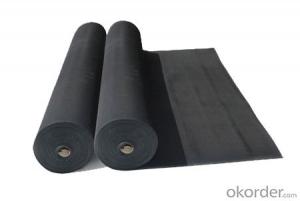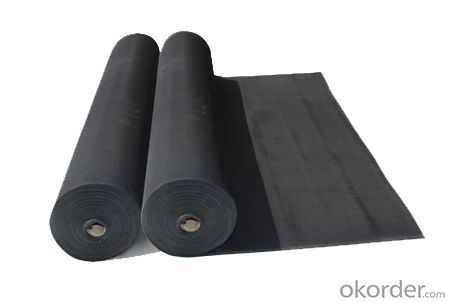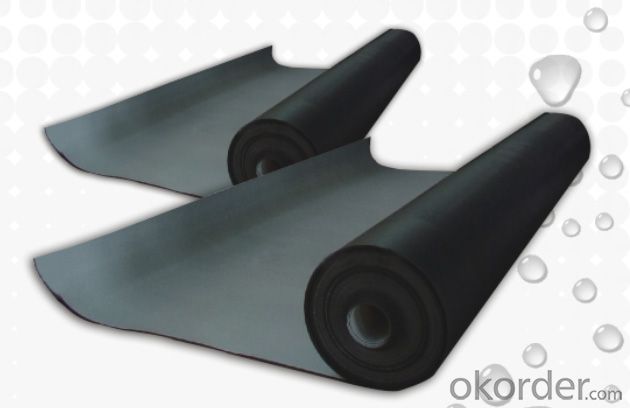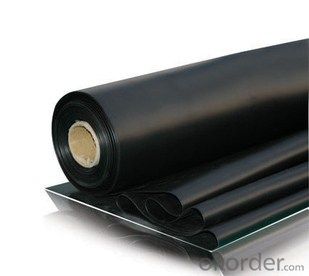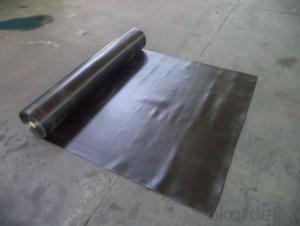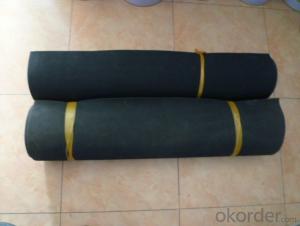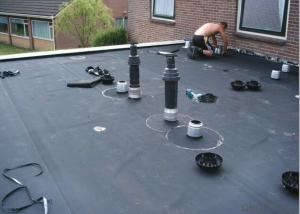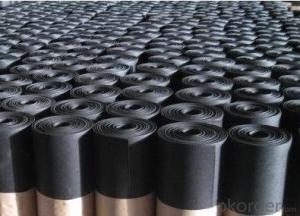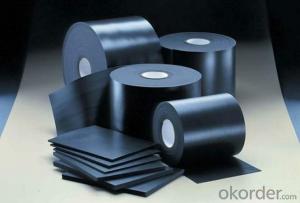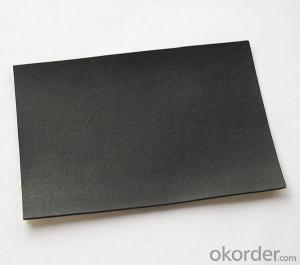EPDM Coiled Rubber Waterproof Membrane for Road
- Loading Port:
- Shanghai
- Payment Terms:
- TT OR LC
- Min Order Qty:
- 50000 m²
- Supply Capability:
- 5000000 m²/month
OKorder Service Pledge
OKorder Financial Service
You Might Also Like
EPDM Coiled Rubber Waterproof Membrane for Road
Description Of EPDM Coiled Rubber Waterproof Membrane for Road:
•EPDM waterproof sheet has excellent anti-ozone-aging performance, able to resist ultraviolet light and corrosion of many chemical corrosive materials in the atmosphere
•It has high tensile strength, high ductility and strong retractility, it has excellent crack resistance, able to effect waterproof function even with tiny vibration of buildings.
• Excellent resistance to ozone, oxidation and sunlight.
• Resistance to chemicals; resistant to most inorganic products.
Main Features of EPDM Coiled Rubber Waterproof Membrane for Road:
A.Polyester based SBS Modified Bitumen Waterproofing Membrane
a. Strong impermeability
b. High tensile strength, elongation, ability to adapt the grassroots shrinkage deformation and cracking
c. Puncture-resistant, broken resistant, tear-resistant
d. The corrosion resistance, resistance to mildew, weathering good
e. Construction convenient, hot-melt can be operated Four Seasons Construction, reliable joints
Specifications of EPDM Coiled Rubber Waterproof Membrane for Road:
| Material | EPDM Rubber |
| Size | 1.2m (width)*20m (length) or customized, weldable type 2.05m or 4m width |
| Thick | 1.2mm, 1.5mm, 2.0mm |
| Type | Vulcanized & Weldable |
| Pattern | Non-reinforced (homogeneous) |
| Certificate | ISO9001/14001 |
Applications of EPDM Coiled Rubber Waterproof Membrane for Road:
1. The substratum should be smooth, dry, clean, which can not have loosing and peeling phenomena.
2. Before application, clean up the basic level and eradicate the impurities.
3. Spread out the membrane on the substratum to loose sheet's stress. Use adhesive-glue to paint the substratum and the surface of membrane. When the adhesive is not sticky to hands, pave and press smoothly.
4. When pave the second volume of membrane, extrude 100mm of the edge of overlap of the first roll and do not paint with the adhesive. Pave the membrane on the substratum according to step so as to finish the whole pavement. When paving, do not tighten the waterproof membrane violently.
5. After that, use the special solvent to scrub the overlap joint. When it becomes fully dry , use the sheet glue to paint the both sides of the joint. Paint it again when it gets completely dry. Till the adhesive is not sticky to hands, press it smoothly and solidly.
6. Pay attention to fire prevention during application. Basement construction site shall be equipped with ventilation facilities



IMages of EPDM Coiled Rubber Waterproof Membrane for Road:




FAQ of EPDM Coiled Rubber Waterproof Membrane for Road:
1. What are we supplying?
We are specialized in producing Colorful Asphalt Roof Shingle, SBS/APP modified bitumen waterproof membrane, Self adhesive bitumen waterproof membrane, PVC waterproofing membrane, EPDM rubber roofing membrane, Single Component Polyurethane Waterproof Coating, and Spray Polyurea Waterproof Coating
.
2. How Many years experience do we have?
We have been exported to more than 20 countries in the past 15 years.
3. How long do we usually reply your request?
We always reply our customer within 24 hours.
- Q: Can a waterproofing membrane be used on flat roofs?
- Flat roofs can indeed benefit from the use of a waterproofing membrane. This method is widely recognized as one of the most effective and commonly used techniques for achieving waterproofing on flat roofs. The membrane itself is a thin material that is carefully applied to the roof's surface in order to prevent any water from seeping through. Typically constructed from durable and flexible substances like synthetic rubber or modified bitumen, the membrane is designed to withstand harsh weather conditions and offer long-lasting protection. By installing the membrane in overlapping layers, a continuous barrier is created that effectively seals the roof, preventing any water leakage into the building. Additionally, it is worth noting that waterproofing membranes can also provide insulation and energy efficiency advantages, which further contributes to their popularity in flat roof applications.
- Q: Can a waterproofing membrane be used on roofs with flat surfaces?
- Yes, a waterproofing membrane can be used on roofs with flat surfaces. Flat roofs are particularly prone to water damage, so a waterproofing membrane is a common solution to prevent leaks and protect the structure beneath. The membrane is applied to the roof surface to create a barrier that prevents water from seeping into the building.
- Q: Can a waterproofing membrane be used on tunnels with fire protection systems?
- Tunnels equipped with fire protection systems can indeed make use of a waterproofing membrane. It is actually quite common to recommend the use of a waterproofing membrane alongside fire protection systems in tunnels, as it adds an extra layer of safeguarding. The purpose of this membrane is to prevent any water from infiltrating the tunnel, as this could potentially harm the fire protection systems and undermine their effectiveness. By ensuring the tunnel remains watertight, the waterproofing membrane preserves the integrity and functionality of the fire protection systems, enabling them to fulfill their intended purpose in the event of a fire. Moreover, the waterproofing membrane can also serve as a barrier, impeding the spread of fire by blocking the passage of flames and smoke. Nonetheless, it is crucial to ensure that the chosen waterproofing membrane is compatible with the specific fire protection systems employed in the tunnel in order to ensure optimum performance and safety.
- Q: How does a waterproofing membrane handle movement of a building due to settling or seismic activity?
- A waterproofing membrane is designed to handle movement of a building caused by settling or seismic activity by providing flexibility and elasticity. It can accommodate small shifts and vibrations without cracking or breaking, ensuring that the waterproof barrier remains intact. The membrane's ability to stretch and contract helps it to adapt to the movement of the structure, preventing water intrusion and maintaining its effectiveness in safeguarding the building against moisture damage.
- Q: Can a waterproofing membrane be used for a parking lot?
- Yes, a waterproofing membrane can be used for a parking lot. Waterproofing membranes are commonly used in parking lots to protect the underlying structure from water damage and extend its lifespan. They provide a barrier against water penetration and can help prevent cracks, deterioration, and corrosion caused by moisture. Additionally, a waterproofing membrane can also help to minimize the formation of potholes and other surface damage.
- Q: Can a waterproofing membrane be used for water tanks or reservoirs?
- Water tanks or reservoirs can benefit from the use of a waterproofing membrane. These membranes are specially designed to create a barrier that prevents water from penetrating the surface. They are commonly utilized in various applications, including water tanks and reservoirs, to ensure that the stored water remains contained and does not leak or seep into the surrounding environment. Typically, the membrane is applied on the interior surface of the tank or reservoir, providing a durable and watertight seal. This helps to maintain the integrity of the water storage system and prevent any potential water loss or contamination. Furthermore, waterproofing membranes also offer protection against corrosion and structural damage caused by water exposure, thus extending the lifespan of the tank or reservoir. Therefore, implementing a waterproofing membrane is an effective solution for guaranteeing the safety and functionality of water tanks or reservoirs.
- Q: Can a waterproofing membrane be used on tunnels with lighting systems?
- Indeed, tunnels with lighting systems can benefit from the utilization of a waterproofing membrane. In reality, it is frequently imperative to employ waterproofing membranes in tunnels to safeguard the structure against water infiltration. These membranes are specifically engineered to establish a barrier, preventing water from permeating the tunnel and inducing harm. Typically, they are administered to the tunnel's walls, floors, and ceilings, and can be seamlessly integrated with lighting systems. The application of a waterproofing membrane will not compromise the functionality or safety of the lighting system, but instead, guarantee that the tunnel remains impervious to water and shielded from issues arising from moisture.
- Q: Can a waterproofing membrane be used for loading docks?
- Yes, a waterproofing membrane can be used for loading docks. Waterproofing membranes are commonly used in construction and can provide a protective barrier against water intrusion, which can be beneficial for loading docks that may be exposed to rain, snow, or other forms of moisture. By applying a waterproofing membrane to the surface of the loading dock, it can help prevent water damage, deterioration, and potential safety hazards.
- Q: Can waterproofing membranes be used on shower walls?
- Indeed, waterproofing membranes are suitable for application on shower walls. They play a crucial role in shower construction by preventing water leakage and safeguarding adjacent areas from potential harm. These membranes act as a barrier, effectively blocking water infiltration into the shower's structural components. Typically, they are installed behind the tile or other wall coverings, serving as an additional protective layer. Designed to be pliable, long-lasting, and moisture-resistant, waterproofing membranes guarantee the preservation of watertight shower walls and safeguard against any water-related harm.
- Q: Can a waterproofing membrane be used for swimming pools?
- Certainly, swimming pools can utilize a waterproofing membrane. These membranes are specifically designed to hinder water infiltration and can be applied to various surfaces, including concrete, to establish a completely impermeable seal. This is especially crucial for swimming pools, as they are continuously exposed to water and necessitate a dependable waterproofing system to avert leaks and water-related harm. The waterproofing membrane acts as a safeguarding barrier, guaranteeing that the pool retains its watertightness and preventing any water from seeping into the nearby structures. Furthermore, waterproofing membranes also offer resistance against chemicals, UV rays, and other environmental factors, effectively fortifying the swimming pool's durability and longevity.
Send your message to us
EPDM Coiled Rubber Waterproof Membrane for Road
- Loading Port:
- Shanghai
- Payment Terms:
- TT OR LC
- Min Order Qty:
- 50000 m²
- Supply Capability:
- 5000000 m²/month
OKorder Service Pledge
OKorder Financial Service
Similar products
Hot products
Hot Searches
Related keywords
